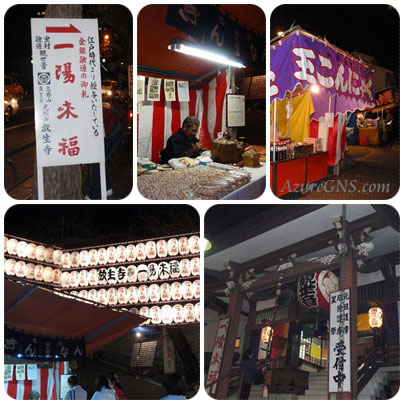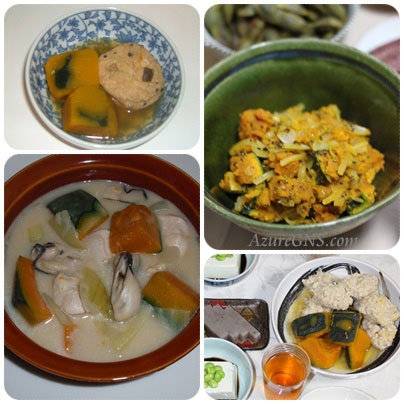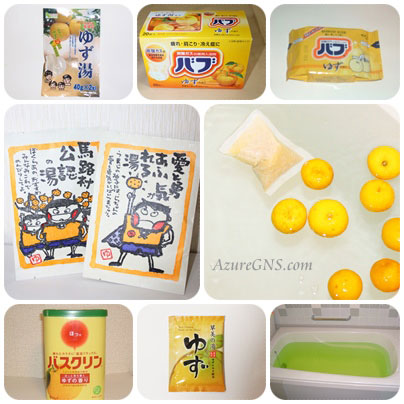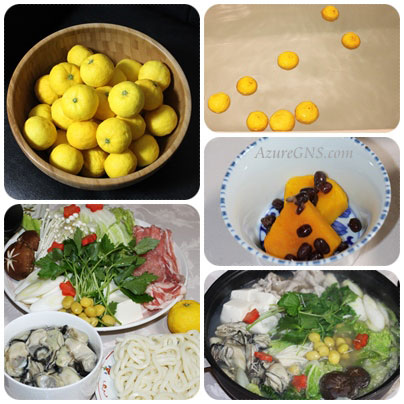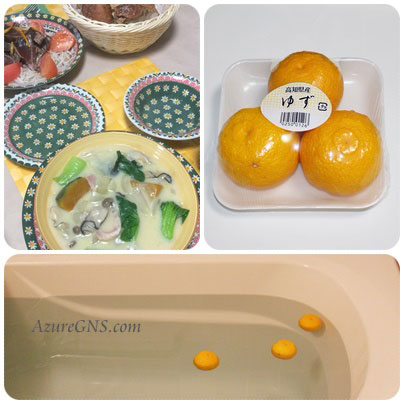Our Toji Experience;
Our Winter Solstice Experience
東京都新宿区の早稲田大学のすぐ近くにある穴八幡宮で、冬至から節分まで授かることができる「一陽来復」の御守は金運に御利益があるということで、多くの人が特に冬至の日に参拝します。私は2009年(平成21年)の冬至に穴八幡宮へ出かけました。境内には神社のお祭りの定番の屋台以外に柚子、柚子飴、金柑など冬至に関係する屋台が出ていました。穴八幡宮は1062年に源義家が奥州からの凱旋の途中、この地に兜と太刀を納め八幡神を祀ったのがその始まりと言われています。江戸時代は歴代将軍もたびたび参拝し、8代将軍徳川吉宗は流鏑馬を奉納しました。現在でも毎年体育の日に近くの戸山公園で流鏑馬が奉納されています。
Religious charms called “Ichiyo-raifuku” are given at Ana-hachimangu Shrine near Waseda University in Shinjuku Ward, Tokyo from Toji (the Winter Solstice) to Setsubun (the day before the beginning of spring). These charms are believed to bring luck for money, and so many people visit and pray at this shrine. On Toji in 2009 (Heisei 21st yr), I visited this shrine. There were stalls which sold things related to Toji such as yuzu (small citrus fruits), yuzu candies and kinkan (cumquats) in addition to the standard stalls for festivals at shrines. Ana-hachimangu Shrine was founded by Minamoto no Yoshiie who dedicated his war helmet and sword to the place where this shrine is located now and enshrined Hachiman (a tutelary deity of warriors) after he won the war in Oshu (a part of the present Iwate Prefecture). In the Edo period, successive shoguns visited and prayed at this shrine, and the 8th shogun, Tokugawa Yoshimune dedicated Yabusame (archery on horseback) to the deity. Even now, the Yabusame dedication is held in Toyama Park nearby on Taiiku-no-hi (the second Monday of October) every year.
穴八幡宮を後にして、隣接する放生寺に向かいました。そこでも「一陽来復」の御守をいただけます。放生寺は1641年(寛永18年)に穴八幡宮を管理するために創建されました。仏教の不殺生の思想より、人間がやむをえず殺生した生物を供養のために魚や動物を放す「放生会」が、第二次世界大戦からの約40年間の中断がありましたが、毎年行われています。放生寺の境内には、銀杏やこんにゃくなど、冬至に食べると縁起良いと言われている「ん」がつく食べ物を売る屋台が出ていました。私は冬至とは何も関係ないのですが、熱々フワフワのたこ焼きを買って頬ばりました。
I left Ana-hachiman Shrine and went to the adjoining Hojo-ji Temple which also gave worshippers a charm “Ichiyo-raifuku”. Hojo-ji Temple was founded to manage Ana-hachiman Shrine in 1641 (Kanei 18th yr). Due to the Buddhist thought of Fusessho (the commandment against killing), fish and birds are released in order to hold a memorial service called “Hojoe” for living creatures that people kill for their needs. “Hojoe” has been held every year except for a long interruption of about 40 years from the start of World War ll. Some stalls sold lucky Toji foods whose names contain “n” such as ginnan (ginkgo nut) and konnyaku (gelatinous food made from the starch of the konnyaku potato). However, I bought and ate hot fluffy Tako-yaki (wheat flour dumplings with octopus pieces inside) which had no connection to Toji.
冬至と言えばほとんどの人が頭に浮かべるのが南瓜です。南瓜は様々なビタミンやカロチンを含む栄養価の高い野菜で、特に食生活が豊かではなかった時代には冬に南瓜を食べると風邪予防になったことが、冬至に南瓜を食べる習慣が生まれたという説があります。和食での一般的な食べ方は煮物です。我が家では冬至の日にかぼちゃのシチューやサラダを作ることもあります。
Speaking of Toji, almost everyone associates this time of year with pumpkin. Pumpkin is a nutritious vegetable containing various vitamins and carotene; eating pumpkin in the winter was believed to prevent people from catching a cold especially in the past when people didn’t have plentiful diets, and that’s why this tradition started and has continued. A typical Japanese dish of pumpkin is Nimono, boiled in broth and seasoned with soy sauce and sugar. I sometimes also make pumpkin stew or salad on Toji.
南瓜、柚子に続く冬至の食材と言えば小豆で、小豆粥や南瓜のいとこ煮がよく食べられます。冬至の時期にはレトルトパックに入ったいとこ煮も売られています。小豆は東アジア原産で古くより広く栽培されています。大豆より2割ほど小さく、色は紫がかった暗い赤褐色で所謂小豆色です。高蛋白低脂肪でビタミンを多く含むなど栄養価も高く、またその色は魔除けの力があると信じられ祝い膳によく使われます。また和菓子の餡作りには欠かせません。
The most popular traditional Toji foods are pumpkin and yuzu followed by azuki beans. Popular dishes of azuki beans on Toji are Azuki-gayu (rice porridge with azuki beans) and Kabocha-no-itokoni (pumpkin and azuki beans boiled and seasoned with soy sauce and sugar). Itokoni literally means “boiled cousins” because the relationship between pumpkin and azuki beans is compared to that of cousins. On and around Toji, Itoko-ni in an instant package is also sold. Azuki beans are native to East Asia and have been raised in many countries since the old days. They are about 20% smaller than soy beans, and their color is so to speak, “azuki-iro” (azuki bean color): purplish, dark reddish brown. Azuki beans are a high-protein, low-fat and nutritious food with many kinds of vitamins, and their color was believed to have a power to protect people from evil. For this reason, azuki beans are often used as an ingredient for meals during celebrations. Also, azuki beans are essential to make Anko (sweetened boiled azuki beans) of Wa-gashi (Japanese sweets).
小豆はきれいに洗った後、水に浸けずにすぐ煮ます。しかし、しばらく浸けておいてから煮た方が、時間短縮でき、アクも取れます。そして小豆のアクを取るために「茹でこぼし」します。つまり小豆を煮て沸騰したら、ざるに上げて煮汁を捨てます。その後新しい水を入れて、出てきたアクを取りながら好みの堅さになるまで1時間から1時間半、コトコト煮ます。圧力釜を使えば時間は大幅に省略できます。ゆでた小豆の缶詰やレトルトパックも販売されています。
It is possible to boil azuki beans without soaking in water after washing them, but if they are soaked for a while before being boiled, they will cook more quickly, and some of the bitterness is removed. “Yude-koboshi” (draining the boiled azuki beans) is required to take away the froth, and then azuki beans in fresh water are simmered for 1 or 1.5 hours until they become the desired softness while the froth is being skimmed off. An autoclave is helpful for saving a lot of time when cooking azuki beans. Canned and instant-packaged boiled azuki beans are also sold.
冬至には柚子をお風呂に浮かべて、柚子湯を楽しむと一年間無病息災と言われています。柚子は香りの良い蜜柑の一種で、冬に収穫されます。柚子の入浴剤を使うとより簡単にそして安価に柚子湯を楽しめます。柚子の入浴剤をお風呂に入れるとお湯がほんのり黄緑色になり、柚子の香りがして、温泉に入っているような気分になります。固形、パウダー、乾燥柚子が小さな紙パックに入っているなど、さまざまなタイプの柚子の入浴剤が入手できます。
On Toji, people enjoy Yuzu-yu; a hot bath with yuzu floating on the water which is to keep people healthy for 1 year. Yuzu is a type of citrus fruit with a sweet smell and are in season in winter. Using yuzu bath incenses is an easier and less expensive way to enjoy Yuzu-yu. The bath with incenses of yuzu is pale yellow green in color, smells like yuzu and makes us feel like we are in Onsen (hot springs). Various types of yuzu bath incenses are available: solid, powder and a small paper bag holding dried yuzu.
2010年(平成22年)の冬至の食事は「ん」のつく食材を中心に料理をしました。お昼は南瓜、人参、銀杏、昆布などを載せたうどんと蒟蒻の煮物です。夕食は南瓜と隠元(いんげん)の煮物と鰊(にしん)の塩焼きを作りました。
On Toji in 2010 (Heisei 22nd yr), I made Toji meals with ingredients whose names include the “n” sound. I made udon (Japanese noodle made from flour) topped with nankin (pumpkin), ninjin (carrot), ginnan (gingko nuts) and konbu (kelp) along with Nimono of using konnyaku for lunch. I made Nimono of nankin and ingen (green beans) and grilled nishin (herring) with salt for dinner.
2013年(平成25年)の我が家の冬至です。柚子が4つしかなかったので、料理と柚子湯に2つずつ使いました。柚子の上を3分の1ほど切り落とし、中をスプーンでくり抜き器にしました。くり抜いた中身を絞って果汁を取り、醤油、砂糖、昆布茶と混ぜて酢の物の合わせ調味料を作りました。茹でたタコと野菜を合わせ調味料と和え、くり抜いた柚子に詰めて柚子釜にしました。この年の南瓜料理は、鴨と甘辛く煮ました。「ん」が付く食べ物は人参と錦糸卵が入った鮭のちらし寿司、糸蒟蒻とちりめんの和え物です。柚子湯のための柚子が2つしかなかったので、柚子の入浴剤も入れました。
These photos are our family’s Toji in 2013 (Heisei 25th). I had only 4 yuzus, so I used 2 for cooking and 2 for Yuzu-yu. I cut off one third of the yuzu and hollowed them out to use as bowls. The seasoning for Su-no-mono was a mixture of juice squeezed from the yuzu, soy sauce, sugar and kobu-cha (kelp powder). Boiled octopus and vegetable were added with the seasoning and put into the yuzu bowls. I boiled pumpkin and duck meat with soy-sauce and sugar for Toji specialties of that year. The dishes with “n” sound ingredients are salmon Chirashi-zushi (sushi topped with sea food, vegetables and other ingredients) with ninjin and kinshi-tamago (cooked beaten egg which is thinly sliced) on top, and Ae-mono (Japanese style salad) of ito-konnyaku (thread-like konnyaku) and chirimen-jako (dried young sardines). Since I had only 2 yuzus for Yuzu-yu, I added yuzu bath incenses.
2014年(平成26年)、静岡県浜名市で小ぶりながらきれいな柚子をたくさん購入することができました。たくさんの柚子を浮かべ、ゆっくりお風呂を楽しみました。夕食には南瓜のいとこ煮を作りました。そして「ん」がつく人参、銀杏、うどんを加えた牡蠣鍋をいただきました。
In 2014 (Heisei 26th yr), I could buy many small but beautiful yuzus in Hamana City, Shizuoka Prefecture. My family and I enjoyed taking a leisurely bath with many yuzus floating. Kabocha-no-itoko-ni was made for dinner. Kaki-nabe, Japanese hot pot dishes of oysters were also made with ingredients whose names contain “n”: ninjin, ginnan and udon.
2016年(平成27年)も柚子は3つだけですが、一年間の無病息災を祈って柚子湯に入りました。 この年の冬至の夕食にも「ん」の付く食材をいろいろ使いました。南瓜と青梗菜の入った牡蠣のシチュー、大根と大蒜と千切りの柚子の皮を添えた鰹のたたき、そしてパンです。
Although we had only 3 yuzus in 2016 (Heisei 27th yr), we took a yuzu-floating bath and prayed for our good health for the year. I used various ingredients with the “n” sound for this year’s Toji dinner as usual: oyster stew with nankin and chingensai (pak choy), Katsuo-no-tataki (seared bonito slices) with daikon (Japanese white radish), ninniku (garlic) and fine strips of yuzu skin, and pan (bread).
我が家の4匹の愛犬も毎年冬至には南瓜を食べ、柚子湯に手を浸します。ふーちゃんとおーちゃんは柚子の香りがあまり好きではなさそうでした。若いすーちゃんとうーちゃんは、柚子の入った水を飲んでしまい怪訝な顔をしながらも楽しそうにはしゃいでいました。毎年の柚湯のおかげなのか、どの子も元気で過ごしています。
On Toji of each year, our beloved 4 dogs eat pumpkin and soak their paws in Yuzu-yu. Fu-chan and Oh-chan didn’t seem to like the scent of yuzu so much. Young Su-chan and U-chan drank yuzu water and looked somewhat puzzled while runnning around. They are healthy maybe thanks to Yuzu-yu every year.
(「冬至」へ戻ります)
(Go back to “The Winter Solstice“)
Copyright (C) Azure Global Network Services. All Rights Reserved.

